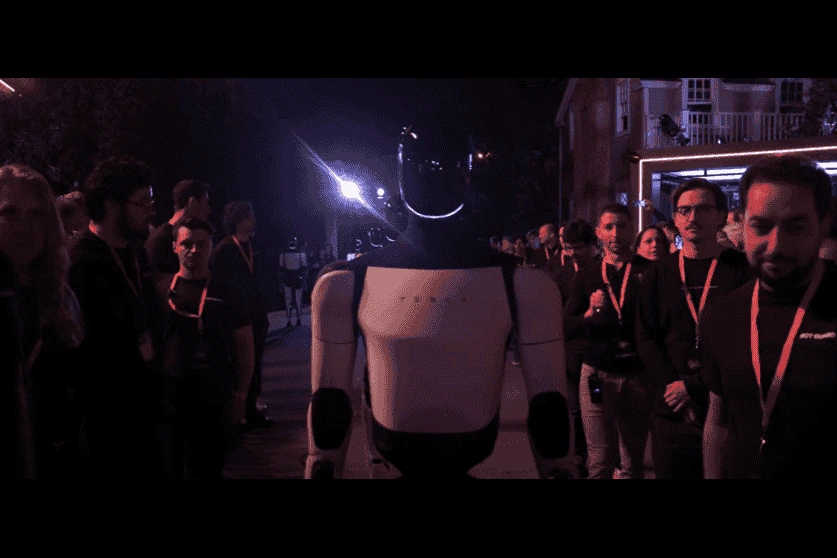Tesla’s latest ‘We, Robot’ event delivered a riveting glimpse into the future. This week’s event showcased some groundbreaking and futuristic tech, including the humanoid robot Optimus, sparking widespread interest and debate. In this article, we break down the event highlights, the evolution of Optimus, what it means for the future, and even some Twitter or X controversies surrounding the robot’s similarities to the 2004 I, Robot film.
Related Post: Could People Ever Work Next To Robots?
Event Highlights
At the heart of the event was Optimus, Tesla’s most advanced humanoid robot to date. Optimus models roamed the stage and interacted with the audience, serving up drinks, striking up conversations, and showing off their agility and precision. The robots, according to Elon Musk, are designed to assist with tasks ranging from household chores like walking your dog to industrial work, representing Tesla’s vision of integrating robotics into everyday life.
More specific details on the upgrade, are on the Liveshow below.
Optimus was not the only highlight of the show. There was also a new Robovan and Cybercap. These are autonomous vehicles designed for a driverless future of public transportation. However, although impressive, these vehicles definitely took a backseat to the show star: Optimus. The humanoid’s ability to perform tasks like handling objects and moving gracefully onstage signalled a step forward in AI-driven robotics.
From concept to reality – The evolution of Optimus
The journey of Optimus began in 2021. During Tesla’s AI Day event, the “robot” presented was actually a human in a robot suit. That move sparked criticism and confusion in the tech world, but Musk promised that something real was coming. In 2023, Optimus 1.0 was revealed. While early prototypes were limited in their abilities, they have demonstrated significant progress over time.
Related post: How Sensitive Robot is Closing the Mechanical Gap
By 2024, Optimus had evolved into a more advanced, semi-autonomous robot. Though some functions are still controlled remotely, its improved physical abilities and AI coordination are good markers of Tesla’s rapid development. The goal here is that the robot will eventually become a fully independent assistant capable of performing complex tasks for households and industries alike. Soon enough, for around $20-30,000, individuals can own Optimus.
The Future of Robotics: Promise and Concerns
Optimus promises to revolutionize the way we live and work. For households, it can handle daily chores, provide care for older people, and even walk your dog. In industries, it can take over repetitive, dangerous tasks and jobs, potentially reducing risks and improving efficiency. While this rapid development is great, there are concerns, and the major one is the potential for job displacement.
Related Post: How Sensitive Robot is Closing the Mechanical Gap
Workers who rely on jobs in domestic work and dangerous industrial settings are mostly from economically disadvantaged backgrounds and may not have access to the resources to transition into higher-skilled roles. While some argue that automation will create new opportunities, enabling people to move into more specialized and skilled positions, the reality is that upward mobility for low-income individuals is often challenging. This rapid technological development is great, but there also needs to be rapid development of safety nets for vulnerable workers facing labor fallout.
Twitter Controversy: The I, Robot Comparison
After the event, a Twitter storm erupted over the resemblance between Optimus and the robots in the 2004 film I, Robot. Fans and critics quickly pointed out the visual similarities between Tesla’s humanoid robot and the NS-5s in the movie.
Moreover, the event name, We Robot, is also quite similar to the movie title I, Robot.
The discussion gained even more traction when I, Robot director Alex Proyas jokingly tweeted, “Hey Elon, can I have my designs back, please?”
Hey Elon, Can I have my designs back please? #ElonMusk #Elon_Musk pic.twitter.com/WPgxHevr6E
— Alex Proyas (@alex_proyas) October 13, 2024
https://platform.twitter.com/widgets.js
While the comment was lighthearted, many took it seriously. Fans debated whether Musk had drawn too much inspiration from Hollywood, with some accusing him of a lack of originality. The backlash highlights the fine line between science fiction becoming a reality and concerns about tech giants borrowing too heavily from fictional sources.
Tesla’s We Robot event solidified the company’s commitment to pushing the boundaries of robotics. Optimus represents the next frontier in AI, promising a world where robots could become household companions and industrial tools.
But the future isn’t without its challenges. Issues like job displacement and autonomy need to be addressed to ensure these advances benefit society as a whole.
As Tesla continues to refine its robots and autonomous vehicles, the world watches with anticipation and some trepidation. Will Optimus become a key player in our daily lives, or will it spark further debate about the role of AI in our future? Either way, Tesla has opened the door to a future where robots may be as common as smartphones today.
Image credits: Tesla
